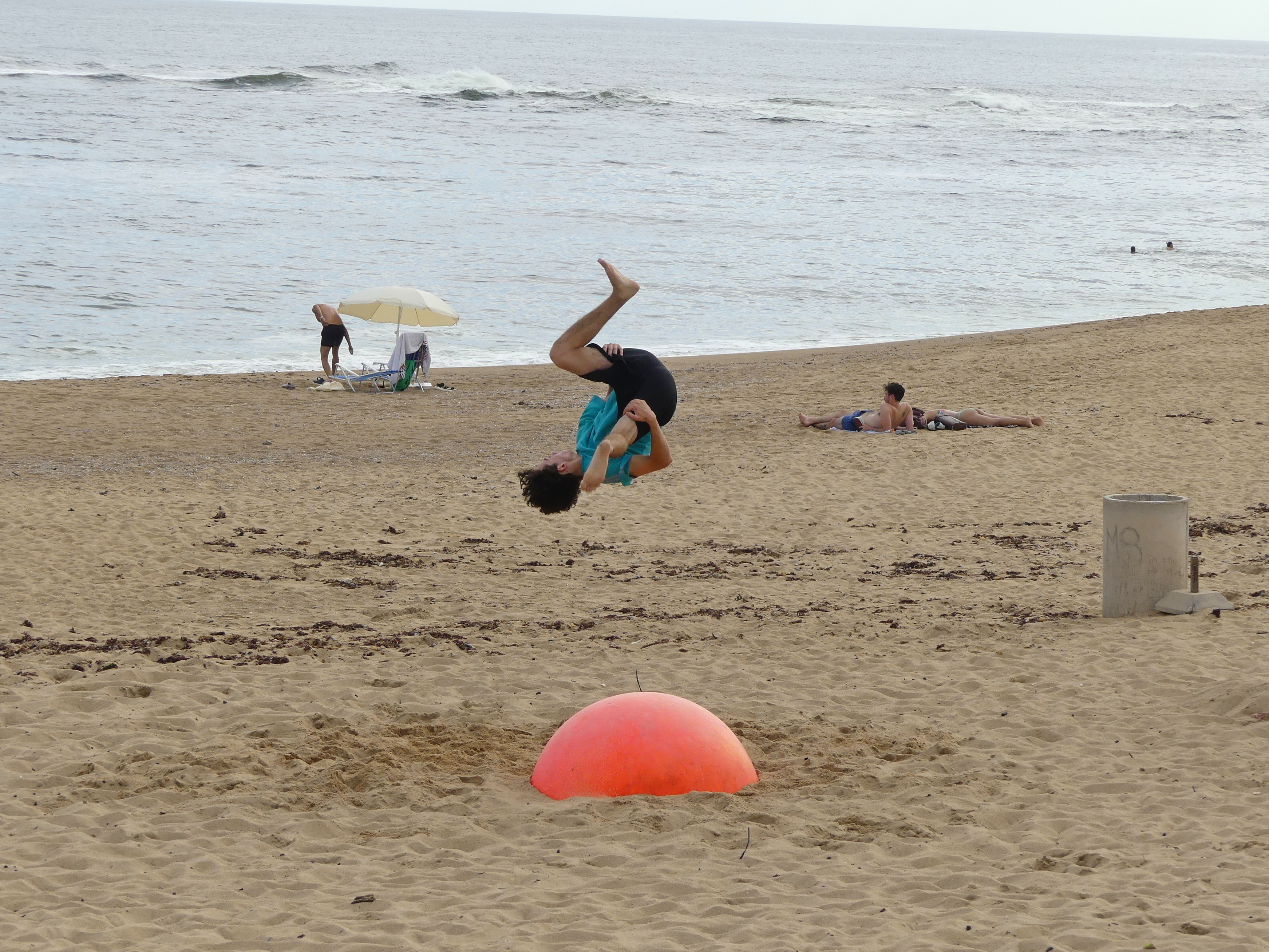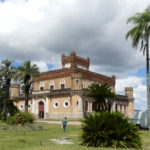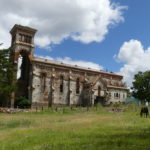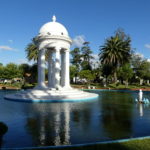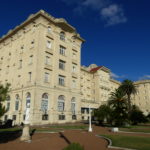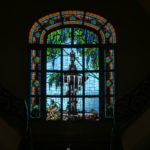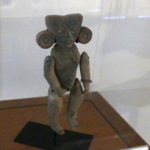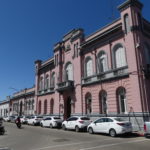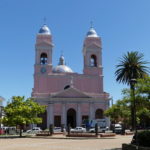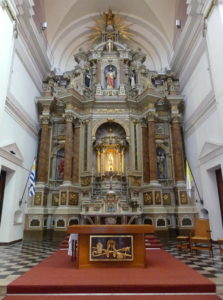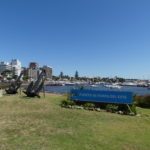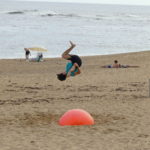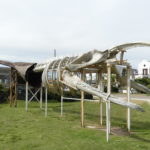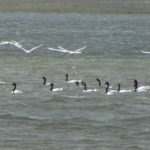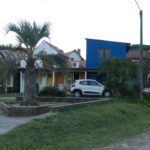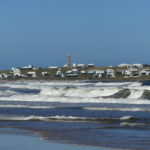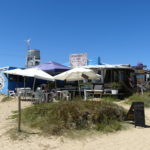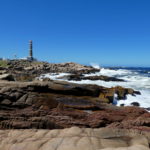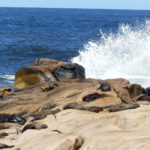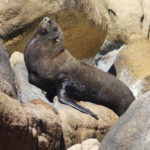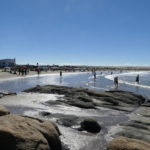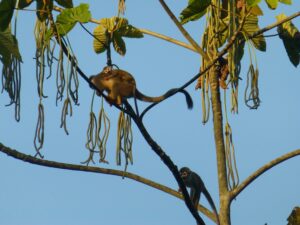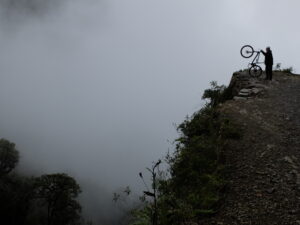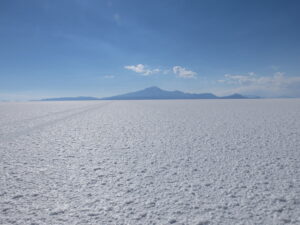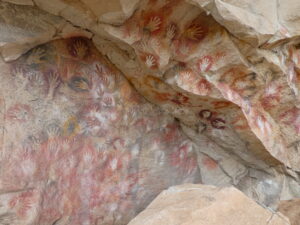Toward the end of our stay in Uruguay, we drove the whole coast, from Montevideo to Chuy, the edge of Brazil. We discovered surprisingly diverse terrain and vibe along the 250 miles (400 kilometers) of Uruguay’s eastern shoreline. The dozen or so beach towns, or balnearios, that dot this coast hearken back to Uruguayan development efforts over a hundred years ago. Their sizes vary greatly today as do their cultures. Each has found a different vibe: wealthy modernism, bohemian, familial practicality, fishing village, hippie, surfer, and so on. For huge stretches in-between the balnearios, pristine beaches attract visitors from the rest of South America. Rocky capes and outcrops attract sea lions and rock-hoppers. Expansive inland lakes with wetlands entice birds and other animals that appeal to hikers, boaters and fishers as well. Whatever you want to experience in shore and sea is there.
PIRIAPOLIS
Closest to Montevideo is Piriapolis. This elaborate town was planned and developed around the turn of the 20th century by a land speculator, Francisco Piria; after his death in 1933, however, things fell apart. It reminded us of another grand project (with apologies to Coleridge)…
In Piriapolis did Francisco
A stately pleasure-dome decree:
Where Zanja’s dribbling river flowed
Through caverns measured out by plan
Down to a sun-lit sea.
He, hectares aplenty of beachside town,
With ordered streets, tree-lined, laid down;
So too set gardens with alchemic thoughts,
Graced by statues, domes and flowering tree;
And wound forested roads up to most hilltops,
Unveiling views or spots of mystery.
A little of its splendor past,
Just enough their minds to blow,
Visitors today still find did last –
As with these photos we can show.
Yet – though on those same streets
So many bars and restaurants cluster,
Plus tacky shops with souvenirs replete –
Sufficient trace it holds of former lustre.
It was a miracle of rare allure,
So richly contrived and still worth a tour.
Piria’s home and fantasy castle is just a few kilometers outside of town. It’s now open to the public but its bare interior shows little of the lifestyle Piria must have lived.
Piria’s church – set on a high ridge between the town and Piria’s castle – was never completed. It stands like an ancient ruin – a kind of metaphor for the whole project. Horses graze around it and firewood is on sale in heaps and heaps next door.
In a lovely park at the foot of Bull Hill is this classical temple, an homage to Venus as the female principle.
Cerro del Toro, Bull Hill, was one of the hillsides that Piria included in his city scheme, an arrangement of grids and diagonals on the flatland. He planned it all based on alchemical/mystical meanings. The bull perhaps represented the male force to be united with the female, Venus. Piria paid well for this bronze bull, sculpted by Antoine Burdelle, a student of Rodin’s, and shipped from France. It was intended as a fountain, and the water still flows from its mouth onto a sculpted grotto.
At the top of Cerro del Toro, Piria’s Bull Hill, we found a breath-taking vista over Piriapolis grand bay, its beaches and the town – as well as a statue of “Helene” on a metal frame festooned with colorful cloths. We didn’t plan this, but we took a chance and followed a steep, boulder-strewn path past the “bull” and a lion statue above it.
Piria himself built the grand Hotel Argentino, whose interior (and 900 rooms) is as vast as its exterior, even today the largest hotel in South America. Visitors can still stay in the rooms here. Behind the hotel, Piria installed a similarly oversized Rose Pavilion as a grand ballroom, built by the Eiffel company in Paris.
Stained glass window in the Hotel Argentino lobby.
The art nouveau interior of the Renaissance style Hotel Colon, a more modest hostelry that Piria built about a kilometer down the beach from his Hotel Argentino. It too is still open for guests. At the stair’s first landing, in the photo, you can see a drawing of the exterior.
MALDONADO
Eastward along the Uruguayan coast past Piriapolis, most people zip past Maldonado, which is conjoined at the hip with its renowned beach town, Punta del Este. It turned out that Maldonado was more our scene, surprising us with its charm and its museums.
The most engaging, and unexpected, of those museums was its Titere, or puppet, museum. There two large rooms showed off puppets, marionettes and dolls from around the world and back to the 6th century. You could even try your hand at shadow puppet play. Delightful!
The Teotihuacan native doll was at least 1300 years old.
Intricately fashioned Javanese shadow puppets…you could try putting on a show with them
Hermes (Mercury), a darling marionette all the way from Romania.
Another museum in Maldonado recalled the 19th century revolutionary history of the country and a third (the Uriburi collection) revealed its important 20th century artists. The town square featured a splendid church with a magnificent neo-Baroque altar to marvel at. Plus we found a great vegetarian cafe near the university. Who needed Punta del Este?!
The neoclassical Cathedral of Saint Ferdinand in Maldonado dates from 1895 officially, after 94 years of off-and-on construction. As is the norm in South America, it faces the main plaza of the city.
The much traveled altar of the Cathedral of St. Ferdinand in Maldonado. The magnificent neo-baroque altar by Antonio Veiga in 1882 was actually fashioned in Buenos Aires, before finding its home here. At the center is a statue of the Virgen del Carmen. In 1829, the statue was credited with saving the lives of the crew on a shipwrecked vessel, the Ciudad del Santander. It was then donated to the Cathedral for further veneration.

The museum housing the Uriburi collection included work of the impressionist painter Pedro Blanes Viale, like this relaxed, large-scale portrait.
The Uriburi museum also included extensive sculptural work by leading Uruguayan artists. Here are three preparatory pieces for larger scale monuments by Jose Zorilla de San Martin, who rivalled Jose Belloni for monumental commissions in the early 20th century. We later saw many of their works around Montevideo.
BEACH TOWNS – BALNEARIOS
After Piriapolis and Maldonado, quiet beaches line the eastern coastof Uruguay, partly on the Rio Plate and partly on the Atlantic. Argentineans and Brazilians love to come here for its endless shoreline, jamming the scattered beach towns in summer. Here are some of the ones we discovered.
The most famous town on the eastern shore is Punta del Este (where the fingers rise from sand). Seamlessly connected with the less touristy city of Maldonado, Punta del Este has become a kind of mini-Miami Beach, with blocks and blocks of mid-rise condos and hotels. Many boats owned by the wealthy nestle in its harbor.
A playful sculpture on the central beach of Punta del Este – or one that seems a bit creepy after a while. Who’s under there…and why? And could we find the feet sticking out at the other end of the globe?
The tiny balneario of Jose Ignacio is one of the wealthiest of the beach towns. Modernist homes are everywhere, blended surprisingly way into the landscape of dunes and scrub. The view from the lighthouse on a rocky point shows why this place is so enticing.
In La Paloma, we spotted a group of young men doing flips off an embedded ball. We were relaxing at one of the few shoreline restaurants on the beach. Uruguay has minimized commercial establishments right on the beaches.
If one tires of endless sand, rocky points and unusual outcroppings like this can be just as diverting.
Among the visitors to the Uruguayan coast are right whales, quite an attraction (when alive in the water) during the fall and winter seasons.
Black headed swans on huge Laguna Rocha. The lake’s opening mouth on the sea is not even two hundred meters wide, but requires a driving detour of about 60 kilometers (35 to 40 miles) in order to proceed eastward on the coast. This lake and its fringe wetlands is the largest of four along in the east, all havens for birds and other animals.
Other wetlands along the shoreline between towns offer plenty of impromptu bird-watching
A colorful block of homes at Aguas Dulces, a small balneario with a very relaxed and family oriented feel, as well as some surprisingly fine places to eat. At its far northern end lies a naturist beach.
Unusual rocky pinnacles spread through the beach at La Pedrera. In the background, you can see an array of beach homes in a style common to the area.
CABO POLONIO
One of the most unusual of these beach towns is Cabo Polonio. The town sits on a rocky cape flanked by grand bays and inviting beaches, and has the look of a semi-permanent Woodstock. It has no true road access. Monster sand trucks outfitted with dozens of seats transport people over the five kilometers of sandy trails from the highway to town.
Cabo Polonio, as it appears from atop the monster truck. Or perhaps a vision of Paradise? The residents have long resisted creating a direct road, preferring the relative isolation and peculiarity of access. Nonetheless, Polonio’s reputation draws thousands of beach lovers per day in season to its calmer bays, filling the parking lot near the main road – even though there are countless other beaches as fine up and down the coastline.
Three of Cabo Polonio’s scattered hostels and colorful residences for rent (pack light, for you must haul your bags over sandy trails).
A restaurant bar – among others set in sand at a distance from the shoreline – seems makeshift, but serves a lot of people. They offer surprisingly cold beer.
The “market street” where residents sell home-made jewelry, trinkets, and other adornments to visitors.
The actual cabo of Cabo Polonio, Cape Polonio, a rocky outcrop outfitted with a splendid lighthouse and flanked by two bays with endless beaches. Rockhopping around here is quite a pleasure, while the water breaks into spray close by along the cliff.
At the cape point, fur seals sleep, fish or waddle – to the delight of human visitors.
A non-human resident at Cabo Polonio.
One of two bays sweeping away from the cape point. This beach is closer to the handful of eateries and bars, while the other is a bit farther off and several times longer.
With so much adjacent seashore to accommodate visitors, the town itself hardly seems as busy as the packed parking lot suggests.
(Also, for more pictures from Uruguay, CLICK HERE to view the slideshow at the end of the itinerary page.)


